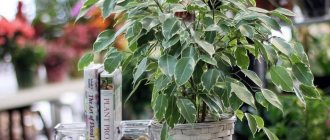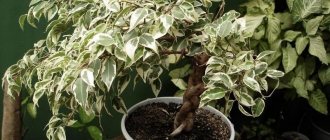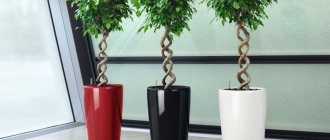There are many opinions about the origin of the name of this plant.
There is an opinion that he was named after the famous botanist. Most people think that the word "benzoya" served as the basis. For a long time it was thought that this ficus was a source of benzoin resin. Although this is not the case, the name has not changed. At home, Ficus Benjamin does not require special care if it has survived the period after moving to another place. After successful adaptation, maintenance is minimal, which is why these plants are valued by designers of residential and office spaces.
Transplant procedure
Ficus benjamina cannot be replanted only at will. There must be a compelling reason from the following list to begin this process:
- The growing container has become too small.
- The root system enveloped the entire earthen ball.
- Replanting is required due to changing the soil or improving the drainage system.
- During reproduction.
As a rule, it is recommended to replant the plant annually. The spring period is chosen for this. And only specimens that have reached 3 or even 4 years of age can be replanted every 3 years. Do not forget to add fresh soil to the container with the plant from time to time.
The container for transplanting Ficus Benjamin should be chosen not too spacious and large. Choose a pot a couple of centimeters wider than the previous one. It is imperative to ensure good drainage.
The flower reacts negatively to alkaline soil or soil with high acidity.
You need to be extremely careful with the root system of the plant. She is very fragile. That is why the entire reproduction process will take place by transshipment along with an earthen lump. A couple of days after transplanting, you can water the plant.
If you purchased ficus benjamina from a specialty store, then do not rush to replant it. You need to wait for the adaptation period to complete, which lasts about a month.
Watering and humidity
Ficus plants are plants from the tropics, so they need moisture as well as light. However, it rarely requires watering in shaded areas.
- In the summer, the roots of the flower consume more water, the soil dries out faster, so the plant needs to be watered every 4-5 days.
- If the soil in the pot is noticeably wet, it should not be watered.
- To ensure comfortable conditions for the tree, you need to wipe its leaves from dust.
- In winter, the plant needs watering once every 10 days.
- When heating an apartment in winter, so that dry air does not damage the leaves of ficus Benjamin, it is recommended to spray them with a sprayer or purchase an electric humidifier.
- Before spraying, the soil is wrapped in polyethylene to prevent washing away.
Crops from the tropics do not have rest time, so they need to create uniform light, moisture and nutrition all year round.
General features of the plant
The genus belongs to the Tutov family. Most representatives are evergreen and only 10% lose their leaves. Domestic and wild species have a solid leaf structure. The stipules are usually large in size and fall off quickly.
Ficus is distinguished by inflorescences with a characteristic ball or pear shape. The buds are formed on the inner surface, and the flowers themselves are small in size and light in color. They can grow singly or form in groups.
Homeland, history and description of ficus species
About 800 species of the family can be found in the tropics. About 100 species grow in subtropical latitudes. Some heat-loving plants live in Mediterranean countries. Most of the species are distributed on the islands of the Pacific and Indian Oceans, in western Africa and Latin America.
The history of ficus trees is quite long - in our time you can admire the tombs of Ancient Egypt, which are made from the African species of this plant. Over many thousands of years, many plant forms have appeared, from giant to dwarf ones. Some ficus trees are considered sacred by Muslims: we are talking about the fig tree and the fig tree.
Ficus is often called the rubber tree. Everything is explained by the special composition of milk, which is found in the leaves and stem. The plant is used for industrial purposes, because its juice consists of 15% rubber. In the wild, many animals eat ficus leaves.
In Africa and Mexico, the leaves of large trees are used during construction to line roofs. In some countries, living bridges are made from ficus trees. To do this, they throw the bamboo over the ditch and wrap it with the aerial roots of the plant. For about 10 years, the vine grows around the supports. Such a structure can support the weight of 50 people who will simultaneously stand on the bridge.
Benjamin
The evergreen plant grows up to 10-20 meters in height. At home it grows as a bush and no higher than 3 meters. The crown has a regular shape and is gray-beige in color. It is so thick that the trunk is difficult to distinguish. An unusual tree shape can be created if the aerial roots of the plant are correctly connected.
Ficus benjamina
The leaves of Ficus Benjamin are oblong in shape, ranging from 5-20 cm in length and 2-5 cm in width. They can be either single-color or two-color, depending on the variety. Many beliefs are associated with this type of ficus. Some claim that it helps in conceiving children and for this purpose the plant is placed in the bedroom.
Rubber-bearing
The most popular type does not require special care. The trunk has a small number of branches and in an apartment can grow up to 2 meters in height. The leaves with a pointed end are elliptical in shape and have a glossy finish. Different varieties have different foliage colors.
Signs and superstitions
People have endowed many indoor plants with special properties. Ficus benjamina is no exception; many are interested in whether it can be placed in residential premises. The cause of concern is the unenviable reputation among the Slavic peoples. This plant is considered a muzhegon. A single woman can only get married if she gets rid of this plant. If there is a man in the house, the ficus will definitely kick him out. This superstition is typical only for the Slavs; in Thailand and China they think differently.
People who follow the rules of Feng Shui believe that
ficus benjamina has positive energy , neutralizes aggression, and helps solve important problems.
In China, it is given to elderly people to prolong their lives. In Thailand, ficus is one of the elements of the coat of arms, as it drives away evil spirits and brings good luck. The first statement has been confirmed by scientists. This plant absorbs benzene, ammonia, and formaldehyde from the air.
In Russia, before the revolution, many people grew ficus benjamina; it was believed that they balanced relationships in the family and helped build a career. Later, this opinion began to be considered a relic, but ficus trees were still bred. After the war, someone noticed that the men did not return to the houses in which the ficus benjamina stood. This radically changed the attitude.
Opinion of modern Russians:
- Benjamin's ficus balances relationships, but gets sick from negativity;
- when placed in the kitchen, well-being increases;
- in the bedroom, ficus relieves insomnia and promotes conception;
- efficiency increases in the office.
Signs are just folklore. You can be interested, but you also need to analyze the information. Any plant is alive, therefore it requires care and reacts to people’s emotions. If you treat Benjamin's ficus kindly, he will respond in kind.
Is the plant suitable for bonsai formation?
To grow a bonsai from a ficus benjamina, you need to regularly trim its roots and crown, giving the branches the desired shape in accordance with one of the directions of this art. Having no experience in growing miniature trees, you should start with the tekkan style - the simplest, classic option.
To form a bonsai you need:
- plant the plant in a wide, flat pot filled with plenty of drainage;
- trim the root system twice a year - shorten the roots by 1/3 and remove the main stem, stimulating the development of thin rootlets;
- after complete rooting, pinch the top of the ficus - this promotes the growth of the crown and roots in breadth;
- shorten branches that have 8-10 leaves, leaving only 2-4.
Expert opinion Andrey Petrovich Mokhov Graduated from KubSAU, specialty: agronomy
For pruning, it is necessary to use sharp, disinfected tools, and treat the cut areas with garden pitch or crushed activated carbon.
You can give the desired shape to the trunk in 2 ways:
- tying the top or branch to the base, achieving a curved appearance;
- wrapping it with wire starting from the roots, giving any desired direction to both the trunk and branches.
When wrapping with wire, you can remove it after 2-3 months, without unraveling it, but cutting it off from the plant to avoid damage to it.
CORDILINA shrub Care, cuttings
Cordilina. Reproduction of cordyline
Cordilina.
Cordilina Care Tips
CORDILINA (Cordyline) Flowering and reproduction. False palm. Dominican Republic
CORDILINA - miniature DRACENA. Features of home care
Previous entry Abutilon (cableweed) Next entry Caring for pachira at home, description, signs and superstitions associated with the flower, types
Transplantation
In the first four years of the plant's life, it grows quickly, so it needs to be replanted every year. At the end of this period, the tree can be left in the same flowerpot if its dimensions are quite suitable, and only the top ball of soil is replaced.
A transplant is recommended if the following signs are noticed:
- Roots have squeezed through the drainage holes;
- After watering, the soil dries out quickly;
- The roots completely entwined the clod of earth.
Transplantation is carried out using the transshipment method.
Care
Since ficus is a tropical plant, it needs good lighting. However, direct scorching rays are not the best option, as is a heating device located near the ficus. If you see that the plant does not have enough natural light, take care of artificial lighting.
Professionals give some more important advice on caring for crops.
- The plant loves humidified air. It should be sprayed once a week with cool water if the microclimate is humid. If the air in the room is dry, you should spray more often.
- One watering per week is the maximum. Ficus trees do not tolerate overwatering.
- The correct approach to the soil is alternating fertile and sandy layers. Thanks to this, the plant will be healthy and long-lived. The soil for ficus should be moist and loose. But you can’t just loosen the soil: in order not to injure the delicate roots, alternating layers provide looseness and air flow.
- As the ficus grows, it should be replanted. If the plant is already mature, then it can live in one tub for years. The main thing is to feed it, periodically replacing the soil.
- The crown needs to be formed in the fall or spring, when the plant is either already going into hibernation or has not yet fully “woke up”. The shoots can be trimmed with pruning shears, but you should not simply break off the branches. Do not forget to treat the sections with a solution of potassium permanganate to prevent rotting.
If you create ideal conditions for a ficus, it can become a long-liver. But if you deny the plant water for a couple of weeks, let it become overgrown with dust, or pour coffee residue and other liquids unsuitable for the crop into the soil, the young plant will most likely die. But adult ficus trees have time to “build up armor”, so they are not so vulnerable.
To stimulate growth, you can use rose bush fertilizer. Nitrogenous mineral fertilizers are good. Ash and tree resin can be used as high-calorie fertilizer.
The plant does not tolerate drafts, so those who like frequent ventilation should think about another green “pet”. Even the most expensive ficus can quickly get sick if placed near a battery. If a putrid smell begins to come from the pot, mold can be diagnosed. In this case, the plant will be saved by replanting. And in order to avoid the invasion of pests that are not averse to feasting on the nutritious leaves of the ficus, the latter need to be wiped more often.
See more about ficuses in the video below.
Creating natural conditions during cultivation
The indoor ficus is unpretentious, so maintaining it is easy and hassle-free. The plant loves light, but does not tolerate direct rays of the sun. It is better to place it on the windowsill on the west or east side. If there are no options, then the south window must be shaded. In winter, you need to take care of artificial lighting.
In summer, maintain the air temperature within 23-27°C, and in winter – 15-20°C. Representatives of the genus are very afraid of drafts; the root system should not be allowed to overcool. In summer it is better to take the flower out onto the balcony. It is important to wait until the temperature at night does not drop below 18°C. Remember that the pot cannot be moved frequently.
Ficus pruning
When watering, you should focus on the condition of the soil. Water the flower when the soil dries 1-2 cm deep. A large plant in a floor pot can be watered 2-3 times less often. Use only purified warm water. It is recommended to pre-stand it for 12 hours.
The tropical plant loves moisture, so give it a small shower periodically. Species with small leaves respond better to spraying than varieties with large leaves.
Remember!
For feeding, you can use organic and mineral fertilizers. Use them only from spring to early summer.
You may be interested in:
Ficus benjamina: home care, transplantation and propagation, photo Ficus belongs to the mulberry family, which is an evergreen plant and looks like a tree or shrub....Read more...
Curly ficus *
#1 Dina
Not in the thunder of a cosmic catastrophe, not in the flames of atomic war, and not even in the grip of overpopulation, but in a well-fed, calm silence, the history of mankind ends. (A. and B. Strugatsky)
#6 Dina
Not in the thunder of a cosmic catastrophe, not in the flames of atomic war, and not even in the grip of overpopulation, but in a well-fed, calm silence, the history of mankind ends. (A. and B. Strugatsky)
#8 Dina
Not in the thunder of a cosmic catastrophe, not in the flames of atomic war, and not even in the grip of overpopulation, but in a well-fed, calm silence, the history of mankind ends. (A. and B. Strugatsky)
#11 Dina
Hm. Net is right. They answered me. They write that a constant temperature of 18-22 is desirable, high humidity, very good lighting, but no direct sun, abundant watering, but not allowing stagnation of water, i.e., good drainage and the pot should also not float in water in the pan. It is better to feed with natural compost (which they sell in bottles, but I think I’ve seen it here too). This Baroque's leaves straighten when the air is constantly too dry, due to improper watering and improper feeding.
Hmmm. It seems that the beauty of my new resident requires great sacrifice. :- ::)
Not in the thunder of a cosmic catastrophe, not in the flames of atomic war, and not even in the grip of overpopulation, but in a well-fed, calm silence, the history of mankind ends. (A. and B. Strugatsky)
#14 Natali
Hmmm. This is either an answer: humidity (the azalea is nearby and everything is fine with it), watering (I am absolutely not inclined to flood my plants, rather the opposite :P), feeding (and without organic matter it will absolutely not curl?
Reproduction: how your Benjamin can bloom
Ficus plants are flowering plants, but do not bloom indoors due to the lack of natural pollination. Small insects pollinate the inflorescences through small holes located in the upper part of the future flower.
Female and male flowers are negligible and do not represent any aesthetic value, but are only suitable for reproduction. At home, ficus can reproduce only vegetatively - by cuttings.
In order for an indoor ficus to feel at home, it needs to create the appropriate conditions. In return, it will become a good friend to its owner, ennoble and cleanse the space, because it is not for nothing that the plant is sacred in many countries of the world.
Indoor plants decorate homes and make the environment more comfortable and welcoming. Many of them are so familiar that people have stopped thinking about their true origin. The real homeland of the popular indoor plant is tropical latitudes; almost 2000 species of ficus grow in forests and only 20 of them can decorate a windowsill. Each domestic type of ficus has its own differences.
Origin of individual varieties of ficus
As mentioned earlier, indoor crop lovers prefer to grow about 2 dozen varieties at home. The rubber-bearing type of flower is recognized as one of the most popular. It grows and develops well, does not require complex care, and has stable immunity to most diseases. It easily tolerates pruning and recovers quickly. This tree-like flower grows up to 2 meters, has dark green oval-shaped foliage up to 35 cm in size. The culture comes from hot countries - Nepal, Burma, West Africa, the Himalayas.
The variety has a variety distinguished by beautiful variegated leaves. Green-leaved varieties are less demanding on growing conditions. The variegated varieties include the rubber-bearing variety Robusta and Black Prince with leaves of the same color. Variegata has green leaves and cream edges, while Doecheri has variegated foliage with a red vein and pink spots on the surface.
Kinds
Experts have bred a great variety of different types of Ficus Benjamin. The differences between them usually lie in the color, shape and size of the leaves.
Here are some of these varieties:
Barok is unpretentious, very similar to a miniature tree and has many subspecies with leaves of different shapes and colors.
Baroque
Anastasia - distinguished by an original pattern of leaves, it is very catchy and patterned.
Anastasia
Starlight - its feature is variegated leaves with white or cream spots on a green background.
Starlight
Golden King - this plant fully lives up to its name; it is the real king of ficus trees. It grows well, allows the formation of beautiful tall trees, and has a noble color of leaves with a golden edge.
Ficus Golden King
Variegated - this handsome guy really doesn’t like to change his surroundings. When purchasing it, find a permanent place for the plant to live.
Variegated
Daniel is a bright, cheerful green representative of the Benjamin ficus. Not as demanding on conditions as its variegated counterparts.
Daniel
Benjamin Mix is a magnificent representative of the genus, which can have leaves of a wide variety of colors - from plain to variegated. Whimsical and requires a lot of attention.
Ficus benjamina Mix
Kinky - easily tolerates haircuts and allows you to form any crown. Also, it is from Kinki that graceful trees with several trunks are “weaved”.
Kinky
Natasha is a dwarf variety of Benjamin with a compact, beautiful crown and variegated oval leaves.
Ficus Natasha
Growing problems
The lower foliage of tree-like species of domestic ficus may fall off from time to time due to natural, or physiological, reasons. Stunting of growth, as well as active loss of green mass, most often results from improper care of the plant.
Stopping growth
The main reasons may lie in a change in conditions of detention. In addition, the plant may stop growing when exposed to drafts, as well as as a result of temperature changes or changes in lighting. Very often, slow growth is caused by a lack of nutrients.
Diseases
Very often, as a result of waterlogging or other improper care, the plant is affected by fungal diseases or root rot. Rotting of the root system is caused by excessive soil moisture. An overabundance of fertilizers also causes the same effect.
Pests
The most common insect pests of ficus are spider mites, mealybugs, thrips, scale insects or false scale insects. Regular examinations allow plant parasites to be detected in a timely manner and corrective measures taken.
Diseases and pests of Ficus Benjamin
Fortunately, pests do not attack this flower so often. Usually these are scale insects, mealybugs and thrips. The scale insects need to be washed off the plant with warm water and laundry soap, and then the bush should be treated with a fungicide (Fitoverm, Aktellik, Aktara). Fungicides will also help against thrips. Mealybugs are collected by hand.
Scale insects suck the life force out of the plant
The leaves of Ficus benjamina may turn pale. This is a direct consequence of lack of lighting. If the leaves look not only pale, but also lethargic, then the ficus is overly flooded with water. Give the plant a rest, and if there is no result, then replanting into a new substrate is required. Rotten roots are removed before transplanting, the rest are watered with Kornevin.
How to get rid of midges in indoor flowers using simple methods. In a special publication on our portal, we will talk in detail about how to get rid of pests in indoor plants. You will learn the reasons for their appearance, the types of midges and their signs and measures to prevent the appearance of midges.
Home care
Ficus benjamina variegated is more whimsical than its fellows.
It grows quite quickly, but requires a lot of light.
It can even live in a spacious, well-lit kitchen.
Considered easy to grow.
If a new tenant has appeared in your house named ficus benjamina with variegated leaves, then immediately decide on the place of his permanent residence.
He really doesn’t like to change the situation!
You need to know the following rules for its habitat:
- maximum lighting;
- protection from direct sunlight;
- away from heating radiators;
- no drafts.
From the first day you can spray the plant up to 2 times a day.
Important: You can replant only after a little adaptation, about three weeks.
Watering
It needs spraying both in summer and winter. Places high demands on the degree of humidity.
Therefore, in winter you need to keep away from heating radiators and use daily spraying.
For irrigation, soft, settled, warm water is used.
In summer, abundant watering is required. Approximately twice a week.
However, you need to make sure that the soil is slightly dry.
Important: The roots should not get wet in water.
In winter, watering is moderate, approximately once every ten days.
They don't need a lot of moisture in winter. From its excess, the lower leaves will fall off and the plant will lose its decorative appearance.
Tip: Once every two weeks, it is recommended to apply liquid organic or mineral fertilizers along with watering.
Bloom
A fact little known to many, but indisputable: the ficus flower is an inflorescence called syconia.
They look more like berries than flowers.
True, they do not bloom in indoor conditions. You can only see this in the greenhouse.
Crown formation
There are two options for crown molding: bush and standard tree.
Bonsai can be grown from this ficus.
If you trim young shoots evenly, you will get a bush.
If you remove side shoots, leaving only one, you will get a standard tree.
To get a well-branched tree, you need to trim the top when the plant reaches 40 cm in height.
This will lead to active growth of lateral branches.
The tops of new shoots can be pinched in spring and autumn, including in adult specimens - this will help turn an unsightly bush into a lush plant.
In addition, in order for the crown to form evenly, from time to time you need to turn the pot with different sides towards the light.
March is considered the most suitable month to begin formative pruning of the crown.
Ground and soil
For planting, you should use fertile soil, preferably neutral, but slightly acidic soil is also possible.
It is imperative to use good drainage (expanded clay on the bottom of the pot).
The composition of the soil can be taken one part at a time in this version: peat, leaf, turf soil and sand.
You can use sand on top of the soil in the pot.
To reduce soil acidity, you can add charcoal (ash) to the soil mixture.
Planting and transplanting
Young ficuses (up to 3-4 years old) are replanted every year.
Although some gardeners advise doing this every second spring, that is, once every two years.
It can be argued that the plant does not like frequent transplants.
The pot is chosen so that its diameter is half the size of the crown.
When the plant becomes too large and the diameter of the pot reaches 30 cm, you can renew the soil without replanting the plant itself.
To do this, the top layer of soil (about 3 cm) is removed and renewed.
Fertilizers can be added to the new soil mixture (about 20% of the soil being replaced).
Landing
Mature plant
To transplant an adult ficus bought in a store into a permanent pot, you need:
- Tilt the plant to one side to remove it from the pot without damage.
- Next, the roots are freed, and the root collar is cleared of transport soil.
- It is important to cover the drainage hole with a mesh, and then pour a drainage layer of expanded clay and sand on top.
- Next, a thin layer of earth is poured in and compacted with your fingers. Without fanaticism, there is no need to deprive the soil of permeability.
- To make it convenient to water the plant, do not add soil to the very top - leave 2 cm to the edge of the pot.
There is no need to deepen the root collar of the plant too much . This can cause leaves to fall off and brown spots to appear.
Read this article on how to transplant a ficus correctly and painlessly.
Semyan
Soak ficus seeds for a day in a special solution.
The use of Humate, Heteroauxin, and Epin will increase seed germination and help increase disease resistance. Plant the prepared seeds in the soil, which you need to prepare yourself. It is better to use light soil, adding a little sand to it . The substrate must be homogeneous and crumbly.
Home care
Care after purchase
Purchase soil suitable for this plant from a specialty store. This can be a substrate for ficus and palm trees.
Pay attention to the acidity of the soil. It should be pH=5-6
Buy a suitable sized clay or ceramic pot.
Place expanded clay drainage on the bottom, which should occupy one quarter of the pot. Now you can start transplanting the ficus into a pot.
During the first few months, monitor the plant's acclimatization.
Yellowing and dropping leaves, drying out roots are a bad sign.
To do this, you need to change the watering or fertilizing regime, temperature or lighting.
Watering
Follow certain rules when watering your ficus:
- Excessive soil moisture harms the plant;
- Watering is carried out only when the top layer of soil dries 2 centimeters;
- In winter and when the temperature drops to 16-19 degrees Celsius, watering should be done little by little;
- At temperatures below 16 degrees Celsius, watering should be stopped completely;
- The use of hard water for irrigation is not allowed.
The water should be at room temperature or slightly warmer.
Bloom
Ficus benjamina blooms extremely rarely in apartments. This usually occurs in greenhouses or open areas.
The ficus inflorescence consists of small spherical berries, hollow inside.
Their color ranges from pale green to deep orange.
Crown formation
Due to the intensive growth of ficus in the spring months, it is necessary to form its crown at this time.
This procedure is not only useful from an aesthetic point of view, but also rejuvenates the plant.
The best tool for pruning is a pruning shears, previously disinfected with alcohol or potassium permanganate.
Trim all main shoots to 20 cm. Make sure each shoot has 5 or more leaves.
All cuts should be made above the kidney.
After completing the procedure, carefully wipe all sections with a dry cloth and sprinkle with crushed charcoal
Ground and soil
The soil for ficus should be neutral or slightly acidic. Preferably fertile.
You can purchase a substrate for ficuses in specialized stores or prepare the soil yourself (for the preparation recipe, see the “Care after purchase” section).
Drainage should consist of an expanded clay bottom layer and a sand top layer.
Planting and transplanting
For planting and replanting, use a suitable size pot made of clay or ceramic. Repot every year between February and March.
In this case, you should increase the diameter of the pot by 4-5 cm. If this value already exceeds 30 cm, you should change 3 cm of the top soil, adding up to 20 percent of organic fertilizers.
Reproduction
To start propagation, select a cutting with the most developed integumentary tissue. Carefully cut it off with a knife.
The resulting cutting should be 10-15 cm in length.
After cutting, it will secrete juice for about a day, so the water must be changed every 2.5 hours.
After 3 weeks, the cuttings, which have taken root, are transplanted into a separate pot.
Temperature
The optimal temperature for ficus "Baroque" differs in summer and winter.
In summer it is 20-25 degrees.
In winter, this value drops to 16-19 degrees, provided that the frequency of watering is reduced.
The plant safely tolerates temperatures below 16 degrees in the absence of watering.
Temperatures that are too high or too low can cause disease or death of the plant.
In the photo Benjamin's ficus "Baroque" (Baroque):
Why do the leaves dry out and turn yellow?
Dry, wrinkled leaves of ficus trees can be ampel-shaped. Leaves may turn yellow for natural reasons - this process may affect the lower leaves. This may occur due to the redirection of vital juices to young foliage. If the leaves have turned yellow en masse, then the problem is different. Read more about the problem in this article.
If you find an error, please select a piece of text and press Ctrl+Enter.
It’s not for nothing that ficus trees are called long-livers: the ficus will live happily ever after as long as the conditions of maintenance and care are satisfactory. Large species of ficus may need updating or pruning if the height of the ceiling does not allow them to grow further.
The photo shows Ficus Benjamin.
House ficus can live about 15 years. But again, this does not guarantee that he will live at least 5-7 years. It's all about proper care. To maintain favorable conditions, it is necessary to monitor the room temperature, humidity, fertilizers, and flower care. And maybe then he will live even longer than 15 years.
Ficus Benjamin has a rather “controversial” character; novice gardeners flatly refuse to acquire this plant. The reason for this attitude towards the tree is its “ability” to shed all its leaves at once if not properly cared for.
Slow plant growth can also be considered a disadvantage of indoor plants. However, if you manage to establish proper care for your ficus, which our article will definitely help you with, then you will get a beautiful, evergreen tree that you can even decorate in bonsai style.
Popular reports
- Report Dodder plant class 3 message Dodder is a widespread weed in all countries, numbering about 150 representatives. It is a rather unpleasant and dangerous neighborhood, since it conducts its life activities at the expense of other plants.
- Report Nuclear weapons in life sciences 10th grade message Nuclear weapons are warheads that have enormous destructive power. This weapon is based on nuclear fusion, which releases the free energy of the atom. Nuclear weapons are considered the most powerful means of mass destruction.
- Message-report on the topic Modification of roots, grade 6. The main functions of roots are to hold the plant and anchor it in the soil, as well as supply it with mineral salts and water. Sometimes additional functions appear at the root, and the rhizome is modified.











